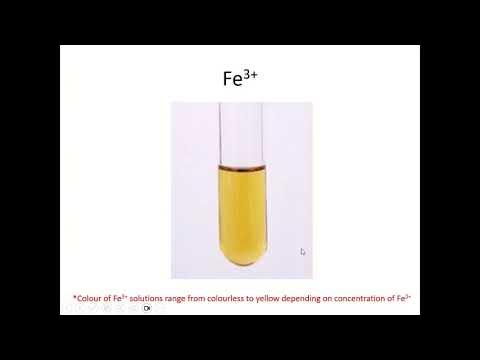CH181 Qulaititave analysis of group 1 cations
Summary
TLDRThis laboratory session focuses on the qualitative analysis of group 1 cations, guiding students through a structured experiment to identify known and unknown mixtures. In Part A, participants prepare a mixture containing lead, silver, and mercury cations, followed by a series of tests to confirm the presence of each ion through distinctive precipitates. Part B involves analyzing an unknown sample using similar methods, emphasizing the importance of careful observation and documentation. The hands-on approach enhances students' understanding of qualitative analysis techniques in chemistry.
Takeaways
- 🔬 Takeaway 1: The lab focuses on the qualitative analysis of Group 1 ions using a known mixture of cations.
- 🧪 Takeaway 2: A positive control experiment involves preparing a mixture of lead nitrate, silver nitrate, and mercury nitrate.
- 💧 Takeaway 3: Hydrochloric acid is added to facilitate the precipitation of cations in the mixture.
- ⚖️ Takeaway 4: Proper centrifugation is essential to separate the solid precipitate from the solution.
- 🚰 Takeaway 5: Distilled water is used to wash the precipitate for purity before further analysis.
- 🔥 Takeaway 6: A hot water bath is employed to dissolve the clean precipitate, followed by centrifugation.
- 🟡 Takeaway 7: The addition of acetic acid and potassium chromate helps confirm the presence of lead ions through a bright yellow precipitate.
- 🌫️ Takeaway 8: Mercury ions can be identified by the formation of a gray solid when ammonia is added to the precipitate.
- 🧪 Takeaway 9: The presence of silver ions is confirmed by the formation of a white precipitate of silver chloride in an acidic solution.
- 📊 Takeaway 10: In part B, students are required to analyze an unknown sample and record results in a flow chart to indicate the presence of Group 1 cations.
Q & A
What is the main objective of the qualitative analysis experiment?
-The main objective is to analyze and identify known and unknown mixtures of group 1 cations.
Which cations are included in the group 1 ions being analyzed?
-The group 1 cations include lead (Pb²⁺), silver (Ag⁺), and mercury (Hg²⁺).
What initial steps are taken to prepare the known mixture of cations?
-The known mixture is prepared by adding 15 drops each of 0.2 M lead nitrate, 0.1 M silver nitrate, and 0.1 M mercury nitrate into a test tube, followed by 2 drops of 6 M hydrochloric acid.
Why is centrifugation performed during the experiment?
-Centrifugation is performed to separate the solid precipitate from the liquid solution, ensuring the analysis focuses on the precipitated ions.
What indicates the presence of lead ions in the supernatant solution?
-The formation of a bright yellow precipitate after adding 3-4 drops of 1 M potassium chromate to the supernatant indicates the presence of lead ions.
How is the presence of mercury ions confirmed in the experiment?
-The presence of mercury ions is confirmed by adding 10-12 drops of 6 M ammonia to the precipitate, resulting in the appearance of a gray solid.
What is the significance of the white precipitate formed in the acidic solution during the silver ion test?
-The formation of a white precipitate of silver chloride in the acidic solution confirms the presence of silver ions.
How should the unknown sample be treated during analysis?
-The unknown sample should be treated similarly to the known mixture by adding 2 drops of 6 M hydrochloric acid and following the same procedures for identification.
What should be documented on the data sheet during the experiment?
-Results indicating positive or negative tests for each ion should be documented, along with a flow chart illustrating the tests and the identified ions in the unknown sample.
What safety measures should be observed in the laboratory during this experiment?
-Laboratory safety measures include wearing personal protective equipment (PPE) and properly disposing of chemical waste.
Outlines

Этот раздел доступен только подписчикам платных тарифов. Пожалуйста, перейдите на платный тариф для доступа.
Перейти на платный тарифMindmap

Этот раздел доступен только подписчикам платных тарифов. Пожалуйста, перейдите на платный тариф для доступа.
Перейти на платный тарифKeywords

Этот раздел доступен только подписчикам платных тарифов. Пожалуйста, перейдите на платный тариф для доступа.
Перейти на платный тарифHighlights

Этот раздел доступен только подписчикам платных тарифов. Пожалуйста, перейдите на платный тариф для доступа.
Перейти на платный тарифTranscripts

Этот раздел доступен только подписчикам платных тарифов. Пожалуйста, перейдите на платный тариф для доступа.
Перейти на платный тарифПосмотреть больше похожих видео

Testing for Macromolecules Lab

Salt Analysis Preliminary Tests Edunovus Online Smart Practicals

P5 - Analisis Kualitatif Kation dengan Metode H2S

O-Level Chemistry | 16 | Qualitative Analysis [1/3]

9701 Chemistry Paper 3 Qualitative Analysis - Part 1 Coloured Cations

Kimia Dasar 2 : Kesetimbangan (Spektrofotometer UV-VIS)
5.0 / 5 (0 votes)
